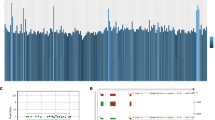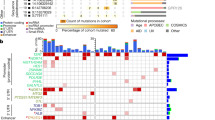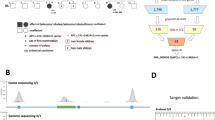Abstract
Mutations in the human homologue of the Drosophila patched gene (PTCH) are responsible for the hereditary disorder called nevoid basal cell carcinoma syndrome (NBCCS). PTCH has a CGG triplet repeat located 4 bp upstream of the first methionine codon. Here we report a novel polymorphism involving the number of the CGG-repeat. The major allele (86.3%) contained a repeat size of seven, whereas the minor allele contained eight. No significant difference in the distributions of genotypes was observed between normal and NBCCS individuals. However, when the repeat was inserted between a heterologous promoter and the luciferase gene, the longer repeats tended to induce higher luciferase activities, suggesting that the repeat length potentially affects the levels of gene expression. A genome-wide screening revealed that 68 and 146 genes contained a CGG/CCG repeat in the coding region and in the 5’-untranslated region (5’-UTR), respectively. None of the genes had this repeat in 3’-UTR. Interestingly, the number of genes with a CGG repeat in the 5’-UTR was significantly higher than that with a CCG repeat in the 5’-UTR. The localization of a CGG/CCG repeat in PTCH is quite unique in that only four other genes have been found in which the repeat is localized up to 4 bp upstream of the first methionine.
Similar content being viewed by others
Introduction
Mutations in the PTCH gene are responsible for the hereditary disorder called nevoid basal cell carcinoma syndrome (NBCCS; MIM# 109400) (Hahn et al., 1996; Johnson et al., 1996). NBCCS, also called Gorlin syndrome, is an autosomal dominant neurocutaneous disorder characterized by developmental abnormalities and tumorigenesis such as palmar and plantar pits, jaw cysts, calcification of the falx cerebri, skeletal anomalies, basal cell carcinoma, ovarian fibroma, and medulloblastoma (Gorlin, 1987). PTCH (MIM# 601309) is a human homologue of the Drosophila segment polarity gene patched. It has been mapped to 9q22.3-q31 and consists of 23 exons encoding a protein with 1,447 amino acid residues. The PTCH protein is a receptor for a secreted molecule Sonic hedgehog and has twelve transmembrane domains. At least two forms of PTCH protein are known to exist, reflecting the use of alternative exon 1a versus 1b (Hahn et al., 1996; Wicking et al. 1997a). Mutations in exon 1b have not been investigated so far due to, at least in part, the extreme GC-rich sequence (Wicking et al. 1997a; Fujii et al. 2003a). In the course of analyzing mutations in exon 1b, using a new set of primers and a PCR condition, we discovered a novel polymorphism involving a CGG trinucleotide repeat immediately upstream of the first in-frame methionine codon. We compared allele frequencies between healthy individuals and NBCCS patients. We also investigated the effect of the repeat length on the gene expression using a heterologous reporter gene. In addition, the results of a genome-wide screening of CGG/CCG-containing genes are demonstrated.
Materials and methods
DNA samples
After informed consent was obtained from 51 healthy, unrelated individuals and 14 patients with NBCCS, total genomic DNAs were isolated from peripheral leukocytes by the standard phenol/chloroform extraction method. Patients were diagnosed as having NBCCS according to the clinical criteria (Kimonis et al. 1997). All studies were approved by the local ethnic committee. Among 14 patients with NBCCS, PTCH mutations were found in 11. Some of the mutations have already been reported (Fujii et al. 1999, Fujii et al. 2003a, Fujii et al. 2003b) and some will be reported elsewhere.
Polymerase chain reaction and sequencing
The genomic region of PTCH including the 5’-untranslated region (5’-UTR) and exon 1b was amplified by using the forward primer, 5’-CGCGCAATGTGGCAATGGAA-3’, and the reverse primer, 5’-AGAGGAGGGAAGAGAAAGTG-3’. The polymerase chain reaction (PCR) was carried out in a 20 μl reaction volume by using LA Taq with GC Buffer (TaKaRa) according to the manufacturer’s instruction. PCR was run for 35 cycles of denaturation at 94°C for 1 min, annealing at 55°C for 1 min, and extension at 72°C for 3 min on a Program Temp Control System PC-800 (ASTEC, Fukuoka, Japan). Both the sense and antisense strands of the PCR products were directly sequenced by using the same primers as described above. PCR products purified by a QIAquick PCR Purification Kit (QIAGEN) were used as the template DNA for cycle sequencing with a CEQ DTCS Quick- Start Kit (Beckman Coulter). Sequencing analysis was performed on a CEQ 8000 Genetic Analysis System (Beckman Coulter) according to the manufacturer’s instructions.
Plasmid construction
Luciferase constructs containing the sequence of PTCH 5’-UTR were generated by a PCR-mediated method described previously (Imai et al. 1991) using pGV-P2 (Wako Chemicals, Osaka, Japan) as a template. The authenticity of all constructs was confirmed by sequencing.
Luciferase assay
The human embryonic kidney cell line 293 growing on six-well culture plates were cotransfected using Effectene reagent (QIAGEN) with 0.5 μg of luciferase plasmid and 0.5 μg of pCMVβGal. The cells were harvested at 24 h after the transfection and used for a luciferase assay. Luciferase activities were measured as described previously and normalized for transfection efficiency based on β-galactosidase activities (Shikama et al. 2001).
Real-time quantitative RT-PCR
Total RNA was extracted from the transfected cells described above using TRIzol reagent (Invitrogen). One-step RT-PCR was performed with a 7700 ABI PRISM Sequence Detector System (Perkin Elmer-Applied Biosystems) using primers 5’-TCTGGATCTACTGGTCTGCCTAA-3’ and 5’-GCGCACTTTGAATCTTGTAATCCTG-3’. To normalize the expression of luciferase, the glyceraldehyde-3-phosphate dehydrogenase (GAPDH) housekeeping gene was also amplified, using primers 5’-GAAGGTGAAGGTCGGAGT-3’ and 5’-GAAGATGGTGATGGGATTTC-3’. Fluorogenic probes 5’-CAAATCATTCCGGATACTGC-3’ and 5’-CAAGCTTCCCGTTCTCAGCC-3’ carrying 5’ 6-carboxy-fluorescein as a reporter dye and 3’ 6-carboxy-tetramethyl-rhodamine as a quencher dye were used to detect the PCR product of luciferase and GAPDH, respectively. In every experiment, GAPDH was amplified using a series of dilutions of a known amount of the standard RNA supplied by Perkin Elmer to prepare a standard curve.
Computational screen
Human mRNA sequences that contain more than seven repeats of CGG were downloaded from NCBI nucleotide databases using the search program termed as “Search for short, nearly exact sequences” with (CGG)7 as a query (http://www.ncbi.nlm.nih.gov/BLAST/). A full screening of the genes of interest was confirmed because genes with exact matches (bit score 42) were followed by the genes with partial matches (bit score less than 42). Genes for unidentified coding sequences were excluded from further study.
Statistical analysis
Genotype distributions and allele frequencies of CGG repeat numbers were compared between cases and controls by means of the ϰ2 test. Odds ratios (OR) and 95% confidence intervals (95% CI) were calculated by Wolf’s method.
Results and discussion
The PTCH gene has two alternative first exons—exon 1a and exon 1b (Fig. 1A). Exon 1b contains the first in-frame methionine codon, while exon 1a is a noncoding exon. We noticed a CGG trinucleotide repeat located 4 bp upstream of the first methionine codon. Although exon 1b is a coding exon, mutations in this exon have not been reported. In the course of analyzing mutations in exon 1b using samples from NBCCS individuals that do not have a mutation elsewhere in PTCH, we discovered a novel polymorphism involving the CGG trinucleotide repeat (Fig. 1B). The major allele contained seven repeats of CGG, while the minor one contained eight (Table 1). As far as we examined, we did not find repeat numbers other than seven or eight. The repeat is conserved among vertebrates, since chicken, mouse, and rat PTCH contain four or five repeats of CGG (Fig. 1C). However, the repeat has not been found in Xenopus PTCH, indicating it is not conserved in amphibians.
A Genomic organization of human PTCH. The PTCH locus based on the sequence AL161729 is shown at the top. Two cDNA sequences, GenBank U43148 and U59464, are generated by alternative splicing using exon 1a and 1b, respectively, as schematically depicted at the bottom. B Nucleotide sequence of the human PTCH gene including 5’-UTR and exon 1b. The first methionine codon is underlined. Polymorphic CGG repeat is boxed. The putative transcription start site is indicated by an arrowhead. C Nucleotide sequence alignment of the PTCH genes. CGG repeat and the first methionine codon are underlined
Abnormal expansion of the CGG triplet repeat in the 5’-UTR of the fragile X mental retardation-1 (FMR1) gene is responsible for fragile X syndrome, in which the repeat is abnormally hypermethylated, resulting in the silence of the FMR1 (reviewed by Jin et al. 2000). Since CGG repeat in PTCH is immediately upstream of the first in-frame methionine codon, the repeat number may influence the efficiency of translation as well as of transcription. To address this issue, various lengths of (CGG)nCAAC were subcloned into the luciferase plasmid pGV-P2 between the SV40 promoter and the coding sequence for luciferase (Fig. 2A), and luciferase assays were performed. Luciferase activities gradually increased with the number of CGG repeats, at least within the range we examined. The highest level of luciferase activity was obtained when cells were transfected with the plasmid pGV-(CGG)19CG(CGG)6, which was generated by chance during PCR reaction (Fig. 2B). These results suggest that individuals with (CGG)8/(CGG)8 have higher levels of PTCH protein expression than those with (CGG)7/(CGG)7. This is contradictory to the case of FMR1. However, it should be noted that in fragile X syndrome, the repeat is massively expanded over 230, and the repeat is located more than 50 bp upstream of the first methionine codon.
A Schematic depiction of reporter gene constructs used for a luciferase assay. Nucleotide sequences inserted between SV40 promoter and the luciferase gene are indicated at the bottom. The first methionine codon of the luciferase gene is underlined. B The effect of the repeat length on luciferase activities; 293 cells transfected with plasmids indicated at the bottom were harvested 24 h after the transfection and subjected to a luciferase assay. C The effect of the repeat length on luciferase transcriptions. Total RNA was extracted from 293 cells transfected with plasmids indicated at the bottom and subjected to a real-time RT-PCR. Luciferase transcriptions were normalized by those of GAPDH
To address the question of whether the difference in luciferase activity is transcriptional or translational, the levels of luciferase RNA expression were quantified by a real-time RT-PCR. As shown in Fig. 2C, in contrast to the activities of luciferase, no significant difference in luciferase transcription was observed. Moreover, unexpectedly, the cells transfected with the plasmid pGV-(CGG)19CG(CGG)6 expressed significantly lower levels of luciferase RNA. Therefore, the increase in luciferase activities with the expansion of the CGG repeat is due to the increased efficiency of translation.
The distributions of genotypes that we observed in NBCCS patients and controls did not differ from the expected frequencies under the assumption of Hardy-Weinberg equilibrium (data not shown), nor were significant associations with NBCCS observed (Table 1). Thus far, no genotype-phenotype correlation between the position of mutations and major clinical features of NBCCS is evident (Wicking et al. 1997b). Since developmental defects associated with the disorder are most likely due to haploinsufficiency, and the repeat length potentially alter the expression levels of PTCH, the repeat number may have an effect on the severity of the disease. It would also be interesting to examine the association of the repeat number with sporadic or noninherited basal cell carcinoma or medulloblastoma, since PTCH acts as a tumor suppressor in these tumors (reviewed by Hunter 1997).
In order to find other genes with CGG repeats, we next performed a genome-wide screening of CGG/CCG-containing genes from NCBI nucleotide databases. A total of 214 genes having seven or more of the repeat number were downloaded. A complete list of the CGG/CCG-containing genes can be obtained from our Web site, http://genetics.nch.go.jp/supplements.htm. Of those 214 genes, 146 (68.2%) contained the repeat in the 5’-UTR (Table 2). Interestingly, significantly more genes have CGG repeats than CCG repeats (65.1% versus 34.9%, P=0.00027). More significantly, none of the downloaded genes contained repeats in the 3’-UTR. The genes containing CGG/CCG repeats in close proximity to their first methionine codons are listed in Table 3. Only five genes including PTCH have intervening sequences of up to 4 bp between (CGG)n/(CCG)n and ATG. In this regard, PTCH is quite unique in terms of the location of the repeat. Considering our results, polymorphisms of the repeat number that might exist in these genes potentially affect their expression levels.
References
Fujii K, Miyashita T, Takanashi J, Sugita K, Kohno Y, Nishie H, Yasumoto S, Furue M, Yamada M (1999) γ-irradiation deregulates cell cycle control and apoptosis in nevoid basal cell carcinoma syndrome-derived cells. Jpn J Cancer Res 90:1351–1357
Fujii K, Kohno Y, Sugita K, Nakamura M, Moroi Y, Urabe K, Furue M, Yamada M, Miyashita T (2003a). Mutations in the human homologue of Drosophila patched in Japanese nevoid basal cell carcinoma syndrome patients. Hum Mutat 21:451–452
Fujii K, Miyashita T, Omata T, Kobayashi K, Takanashi J, Kouchi K, Yamada M, Kohno Y (2003b) Gorlin syndrome with ulcerative colitis in a Japanese girl. Am J Med Genet 121:65–68
Gorlin RJ (1987) Nevoid basal-cell carcinoma syndrome. Medicine 66:98–113
Hahn H, Wicking C, Zaphiropoulous PG, Gailani MR, Shanley S, Chidambaram A, Vorechovsky I, Holmberg E, Unden AB, Gillies S, Negus K, Smyth I, Pressman C, Leffell DJ, Gerrard B, Goldstein AM, Dean M, Toftgard R, Chenevix-Trench G, Wainwright B, Bale AE (1996) Mutations of the human homolog of Drosophila patched in the nevoid basal cell carcinoma syndrome. Cell 85:841–851
Hunter T (1997) Oncoprotein networks. Cell 88, 333–346
Imai Y, Matsushima Y, Sugimura T, Terada M (1991) A simple and rapid method for generating a deletion by PCR. Nucleic Acids Res 19:2785
Jin P, Warren ST (2000) Understanding the molecular basis of fragile X syndrome. Hum Mol Genet 9:901–908
Johnson RL, Rothman AL, Xie J, Goodrich LV, Bare JW, Bonifas JM, Quinn AG, Myers RM, Cox DR, Epstein EH, Jr, Scott MP (1996). Human homolog of patched, a candidate gene for the basal cell nevus syndrome. Science 272:1668–1671
Kimonis VE, Goldstein AM, Pastakia B, Yang ML, Kase R, DiGiovanna JJ, Bale AE, Bale SJ (1997) Clinical manifestations in 105 persons with nevoid basal cell carcinoma syndrome. Am J Med Genet 69:299–308
Shikama Y, U M, Miyashita T, Yamada M (2001) Comprehensive studies on subcellular localizations and cell death-Inducing activities of eight GFP-tagged apoptosis-related caspases. Exp Cell Res 264:315–325
Wicking C, Gillies S, Smyth I, Shanley S, Fowles L, Ratcliffe J, Wainwright B, Chenevix-Trench G (1997a) De novo mutations of the patched gene in nevoid basal cell carcinoma syndrome help to define the clinical phenotype. Am J Med Genet 73:304–307
Wicking C, Shanley S, Smyth I, Gillies S, Negus K, Graham S, Suthers G, Haites N, Edwards M, Wainwright B, Chenevix-Trench G (1997b). Most germ-line mutations in the nevoid basal cell carcinoma syndrome lead to a premature termination of the PATCHED protein, and no genotype-phenotype correlations are evident. Am J Hum Genet 60:21–26
Acknowledgements
We would like to thank the patients and family members as well as the clinicians who contributed to this study. We gratefully acknowledge assistance from Mami U, Kaori Inoue, and Kayoko Saito. This study was supported in part by grants for Brain Research, Pediatric Research, Cancer Research, and Genome Research from the Ministry of Health and Welfare, and a Grant-in-Aid for Scientific Research and the Budget for Nuclear Research from the Ministry of Education, Culture, Sports, Science, and Technology.
Author information
Authors and Affiliations
Corresponding author
Rights and permissions
About this article
Cite this article
Nagao, K., Fujii, K., Yamada, M. et al. Identification of a novel polymorphism involving a CGG repeat in the PTCH gene and a genome-wide screening of CGG-containing genes. J Hum Genet 49, 97–101 (2004). https://doi.org/10.1007/s10038-003-0117-0
Received:
Accepted:
Published:
Issue Date:
DOI: https://doi.org/10.1007/s10038-003-0117-0
Keywords
This article is cited by
-
Basal cell carcinoma: biology, morphology and clinical implications
Modern Pathology (2006)





